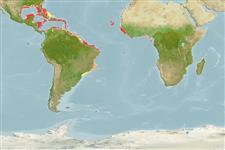Common names from other countries
>
Mulliformes (Goatfishes) >
Mullidae (Goatfishes)
Etymology: Mulloidichthys: Latin, mullus = soft + Greek, ichthys = fish (Ref. 45335).
More on author: Cuvier.
Environment: milieu / climate zone / depth range / distribution range
Ecologia
marino associati a barriera corallina; distribuzione batimetrica 0 - 49 m (Ref. 9710), usually 0 - 35 m (Ref. 40849). Subtropical; 33°N - 26°S, 98°W - 8°E
Western Atlantic: Bermuda and Florida, USA to Brazil, including the Gulf of Mexico and the Caribbean Sea (Ref. 9626). Eastern Atlantic: single record from Ile de Sào Tiago, Baie de Tarrafal, Cape Verde (Ref. 7313). Reported from São Tomé Island (Ref. 34088).
Length at first maturity / Size / Peso / Age
Maturity: Lm 17.0 range ? - ? cm
Max length : 44.8 cm TL maschio/sesso non determinato; (Ref. 104752); common length : 28.0 cm TL maschio/sesso non determinato; (Ref. 3792)
Spine dorsali (totale) : 9; Raggi dorsali molli (totale) : 8; Spine anali: 2; Raggi anali molli: 6. Body pale tan with distinctive yellow stripe from eye to caudal fin; tail yellow. Less brightly colored than other species and is the only one with a single yellow stripe along side (Ref. 26938).
Found over sandy areas of lagoon and seaward reefs (Ref. 9710). Often in schools (Ref. 26938). Forms schools with the smallmouth grunt (Haemulon chrysargyreum), an association regarded as social protective mimicry (Ref. 52492). Juveniles are common in seagrass beds (Ref. 9710). Feeds on benthic invertebrates (Ref. 7313). Marketed fresh (Ref. 3792).
Life cycle and mating behavior
Maturities | Riproduzione | Spawnings | Egg(s) | Fecundities | Larve
Robins, C.R. and G.C. Ray, 1986. A field guide to Atlantic coast fishes of North America. Houghton Mifflin Company, Boston, U.S.A. 354 p. (Ref. 7251)
IUCN Red List Status (Ref. 130435)
CITES (Ref. 128078)
Not Evaluated
Threat to humans
Reports of ciguatera poisoning (Ref. 30303)
Human uses
Pesca: scarso interesse commerciale
Strumenti
Special reports
Download XML
Fonti Internet
Estimates based on models
Preferred temperature (Ref.
115969): 23.4 - 28, mean 26.6 (based on 720 cells).
Phylogenetic diversity index (Ref.
82804): PD
50 = 0.5078 [Uniqueness, from 0.5 = low to 2.0 = high].
Bayesian length-weight: a=0.01047 (0.00920 - 0.01192), b=3.10 (3.06 - 3.14), in cm Total Length, based on LWR estimates for this species (Ref.
93245).
Trophic level (Ref.
69278): 3.2 ±0.1 se; based on diet studies.
Resilienza (Ref.
120179): Medio, tempo minimo di raddoppiamento della popolazione 1.4 - 4.4 anni (Preliminary K or Fecundity.).
Fishing Vulnerability (Ref.
59153): Low to moderate vulnerability (35 of 100).
